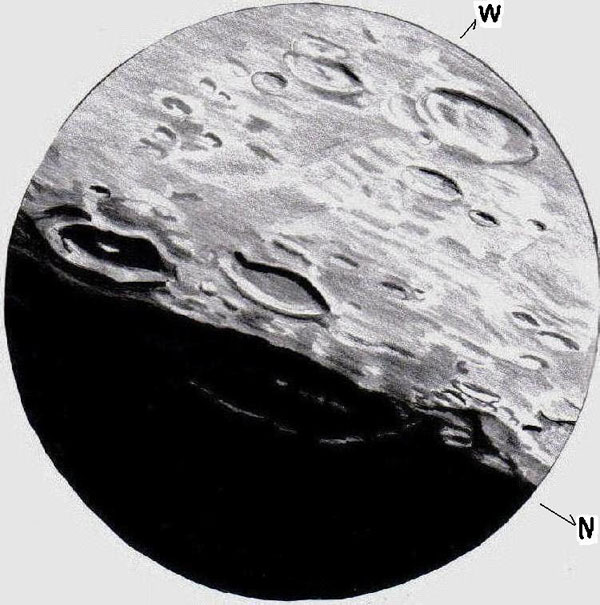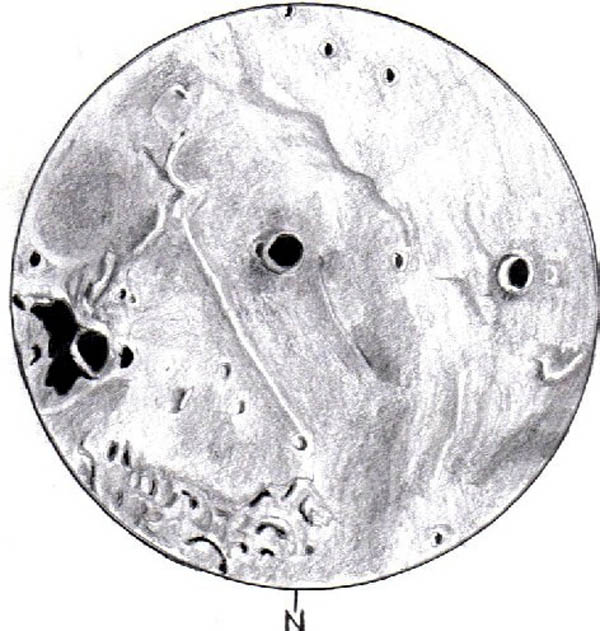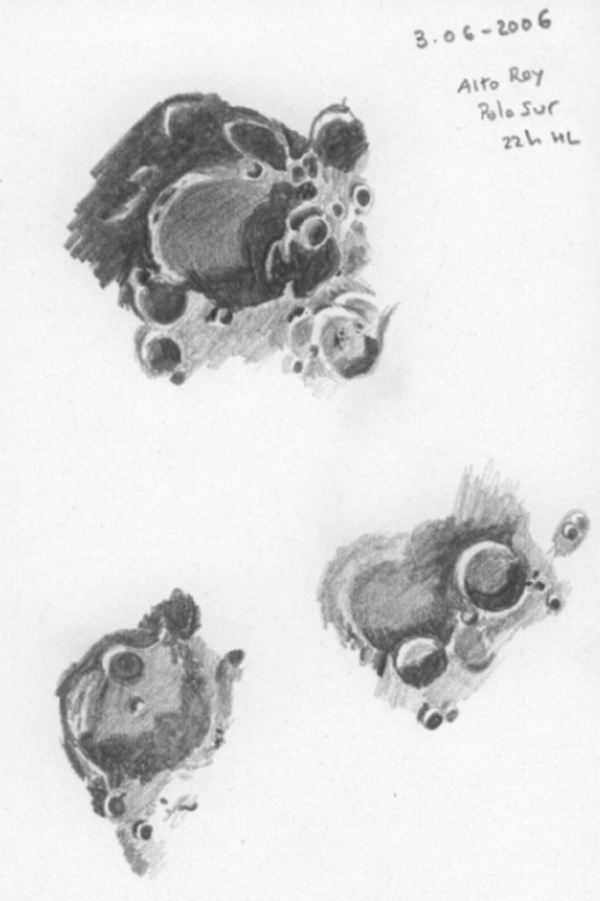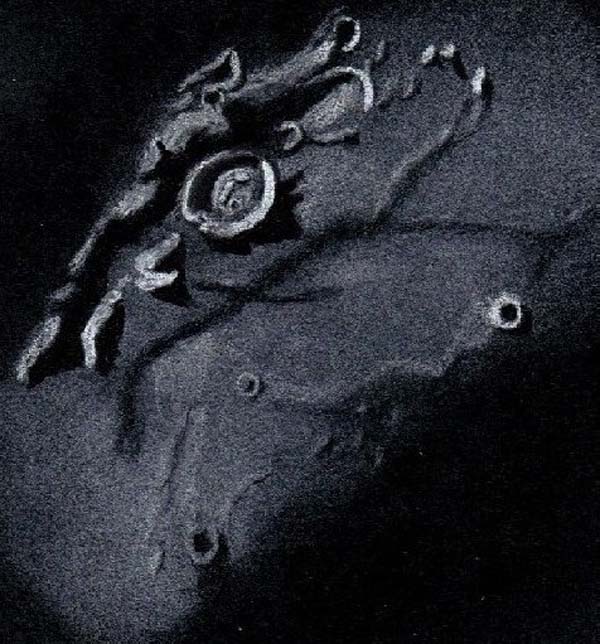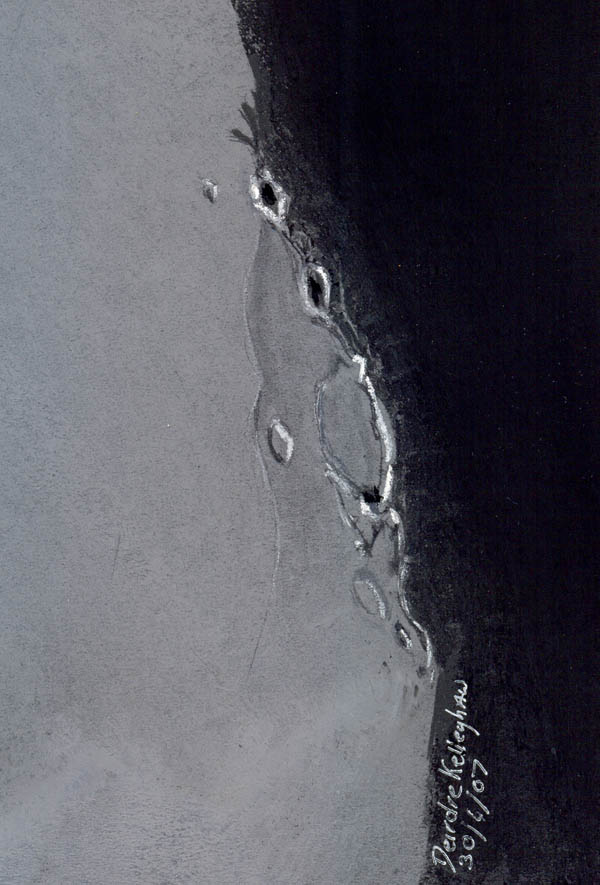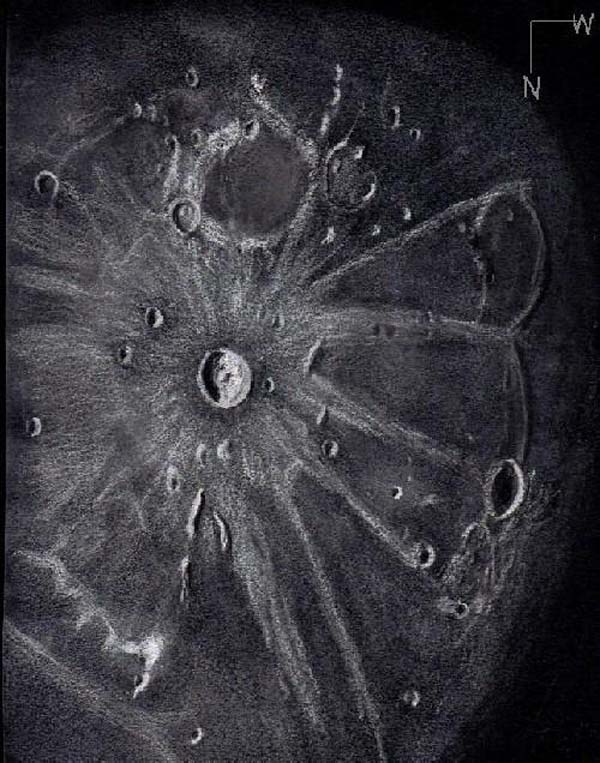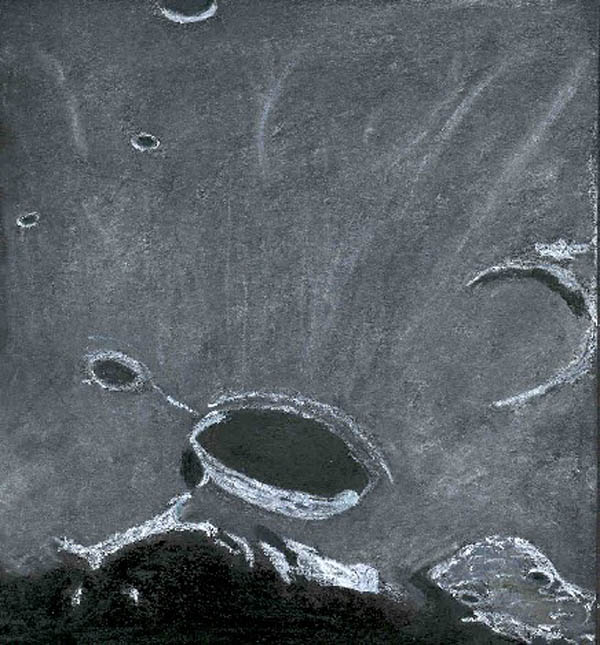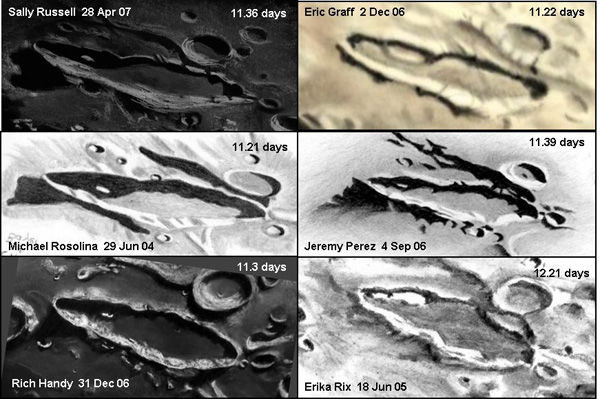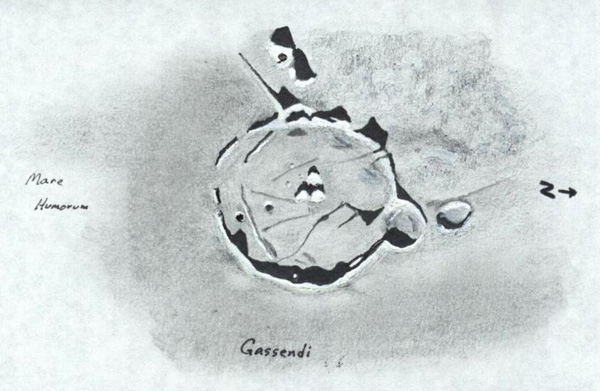At one day past full moon old luna was arching it’s way to the high point for the
night when I selected for my sketching target craters along the terminator on the
eastern side of the moon. Six craters larger than 45 kilometers in diameter are
included in this sketch. With only the highest points along the western rim being
touched by sun rays, it is sundown at crater Gauss. With Gauss measuring 177 km.
in diameter it is categorized as a walled plain crater and dates back to the
Nectarian age (3.9-3.8 billion years ago). Southwest of Gauss with the floor in
darkness except for the illuminated central peak we have crater Hahn, a formation
slightly younger than Gauss and smaller at 84 km. To the north of Hahn is a crater
of the same age as Gauss known as Berosus. It measures 77 km in diameter and its
western wall is not as high as that of its partner Hahn. The largest crater on the
western side of the sketch is Geminus at 86 km. It has a low central peak and no
crater rays, although it is the youngest of the craters in the sketch at about 2 billion
years of age. The smaller crater close to Geminus to the east is 47 km. crater
Bernoulli. And finally to the south of Geminus is crater Burckhardt at 57 km. in
diameter with small craters straddling it to the southeast and southwest.
Sketching: Graphite 2H pencils and India ink on
White 8.5”x11” copy paper
Telescope: 10” f/5.7 Dobsonian 6mm eyepiece
Time: 10-8-2006, 5:30-6:30 UT
Colongitude: 101.6°
Weather: clear, calm
Seeing : Antoniadi III
Frank McCabe
Category: crater
The Ever Popular Rupes Recta
In the morning hours before sun-up the early waning crescent moon was superimposed
on the firmament just west of the Pleiades. I was somewhat transfixed by this
scene but I was set up to sketch “straight wall” on the floor of the lunar Sea of
Clouds. From the eastern edge of Mare Nubium you can see the Triplet craters
Thebit (57 km), A and L. Next moving westward is the Imbrian escarpment Rupes
Recta , not a true wall in the usual sense but on one side standing more than 300
meters high at some points and 114 km in length. The scarp face would be visible
from crater Birt (17 km) to the west, the youngest of the larger craters sketched
here. Touching the rim of Birt to the east is Birt A. Continuing westward we see
Rima Birt a 51 km rille from the Imbriam epoch. At the end of the rille to the
south, is tiny 3 km crater Birt F seen in this sketch. Finally sitting on a
wrinkle in the floor of the mare is crater Nicollet (15 km) a Eratosthenian epoch
impact scar.
Sketching:
For this sketch I used: white copy paper, graphite pencil and pen and ink
Contrast adjusted with Imageenhance software
Telesccope: 18 inch f/ 5 Dobsonian working at 222X (9mm ocular)
Date: 8-16-2006 9:30-10:35 UT
Temperature: 17°C ( 62°F)
Clear, calm
Seeing: Antoniadi III
Colongitude 178 °
Lunation 22.3 days
Illumination 45.9%
Frank McCabe
Three craters from the top of Alto Rey
Hi Friends,
I would like to share my sketches with all of you, I have lots of them in
my notebook and when I discovered the ASOD site recently I was surprised and happy
to find it. Its wonderful, a really good idea.
I made this sketch of three moon craters of the southern region with graphite
pencil on white paper, three craters are hand made without processing after,
just painted looking directly through the ocular and with red light. They
took me almost an hour aproximately.
The equipment used: Meade 8″ SC. Date:
3 Jun 2006; Moon age: 8 days.
The night were very good conditions, I was on top of a mountain called Alto
Rey in Guadalajara, Spain.
All my drawings are almost first drafts in the place of observation, the
best I try to do them again and then more good and after change to negative
to get them more real. I havent still practice with photoshop, but I will
try it.
All my drafts are kept tenderly because they are the result of the night,
all filled with annotations and details by hand,
I hope you enjoy!
Thanks a lot.
Leonor Ana
Cup of nectar
Crater Bohnenberger in Eastern Mare Nectaris
From my location, this evening presented the best observing conditions since June
of last year. As the sun set in the west-northwest the crescent moon was riding
about 55° above the horizon, so I spent about hour looking for potential targets
to sketch. Crater Taruntius presented an interesting sketching target with its
central peak and unusual wall but I wanted to sketch closer to the terminator. I
finally settled on crater Bohnenberger just west of the Lunar Pyrenees Mountains
that define the eastern edge of the Sea of Nectar.
Bohnenberger is an old Pre-Imbrium crater 33 km diameter. Bohnenberger has a pair
of broad central peaks, a break in its northern wall and a crater on its western
floor. Crater Bohnenberger A about the same size (30 km) with a bright, shallow,
flat floor can be seen to the south with 12 km crater G between them. Some 100 km
to the west of Bohnenberger A, crater Rosse could be seen among the lunar ridges
in the Sea of Nectar. The high walls of Rosse were brightly lit against the dark
frozen lava of the mare. The dark shallow crater about the same size as Rosse at
the bottom of the sketch is crater Gaudibert H. Within the region of the sketch a
great deal more could be seen but was beyond my ability to record in a reasonable
time as the shadows and light continued to change.
Sketching:
For this sketch I used: black Strathmore 400 Artagain paper 9”x12”, white and
black Conte’ pastel pencils and a blending stump.
Before submitting I changed slightly the contrast using Imageenhance software
Telesccope: 10 inch f/ 5.7 Dobsonian and 6 mm eyepiece 241X
Date: 4-22-2007 1:35-2:40 UT
Temperature: 20° C (69° F)
Clear, calm
Seeing: Antoniadi I-II
Colongitude 325.7 °
Lunation 4.5 days
Illumination 27.5 %
Frank McCabe
Heavy light
Cardanus, Krafft, Eddington,Seleucus,Briggs, Briggs B, W Oceanus Procellarum
South Telescope build by Grubb Dublin 1868
Fl ? 18Ft 10.7inches/Objective 11.75 inches
Eyepiece? Objective by Cauchoix 1829
Dunsink Observatory Dublin
53° 22′ 60N 6° 19′ 60W
April 30th 2007
20:50UT – 21:57UT
Lunation 13.43 days
Illumination 98%
Seeing 1-2
T poor/hazy
300gm Daler Paper/Daler Soft Pastels/Conte Crayons/ Quilling
needle/Blending stick
I was fourteen years when old I first looked through the South Telescope in Dunsink Observatory. I had pestered my dad to bring me out there, a bit of a long drive in those days, before motorways.
Jupiter was on view that evening, it was crystal clear. The planet must have been quite high as I could look through the Grubb standing up.
I had my own little Tasco scope on a plastic tripod at the time not much to see in it, but the moon always got a look. Ever since I wanted to revisit that moment and look once again through the eyepiece of this well constructed classic telescope. Over the years I paid several visits to the observatory public nights, but always cloud or rain or both.
I got an idea in my head a few months ago, I asked for time to sketch something through the eyepiece this request yielded a positive answer, but it took time to set up.
April 30th 2007 I got a phone call from, let’s say my host in Dunsink “would you like to try tonight”? I was out the door and on the M50 with my gear in less then 10 minutes, an hour’s drive to the Observatory.
I was greeted warmly and the dome was opened, the scope set up, the steps in place.
My position for the next hour and ten minutes was probably the most uncomfortable sketching position in which I had ever worked. I was neither seated or standing, no tracking, and a big telescope to move.
The Grubb was so well balanced, easy to use, a joy to hold, and a privilege to use.
Left alone for the most part I quickly got into my zoned in or zoned out
(depends on your point view) sketching mode.
The eyepiece was low powered generating most likely 125X, used for public viewing, other eyepieces maybe available if I get to repeat this astronomical adventure.
Apart from the difficult sketching position, I felt so at home in Dunsink Observatory, it felt so moreish. Up and down moving the steps, to follow the Moon as she charged along heading for her bed. My concentration waned after an hour, more work to do than in my garden. I was stiff the next morning but I was high as a kite, I got to do something with this instrument made so carefully many years ago in Dublin. A full circle moment in my life, moments that seem to happen with more frequency these days.
In brief periods, when the image was still I could see much more detail and fine tones of grey than in my Dob. Eddington gave me great shapes and that ridge was so so slender, only 2% of the Moon was in darkness and even a little of that was seeping through the blackness into the day.
I admire Arthur Stanley Eddington for his communication prowess during his life.
A poem he wrote came to mind on the way home,
“Oh leave the Wise our measures to collate
One thing at least is certain, light has weight
One thing is certain and the rest debate
Light rays, when near the Sun, do not go straight. “ A.S.Eddington
Apart from this poem being about gravitational lensing, the phrase “light has weight” sticks out to me as an artist. Drawing in the sunlit wall on the western side of Eddington, 138km or so of sunlit weight, which was up till that lunation invisible, non existing until our sun made it so.
A bright note in his Music of the the Spheres
Crater Kepler and its Rays
At nearly 12 days into the current lunation sunlight is bathing young crater
Kepler and its extensive ray system. Kepler falls into the category of a smallish
complex crater (31 km in diameter and 2.75 km deep) with a low peak rising from an
otherwise small flat central floor. Most of the floor is covered with slumped wall
debris. A small part of the inner wall appeared terraced. Crater Kepler lies
between the Oceanus Procellarum and the Mare Insularum both of which are made of
dark lavas. Very prominent rays extend from the rampart and ejecta blanket well
beyond the crater rim for more than 300 km. Some of the rays, especially in the
east, overlap rays of other craters such as Copernicus.
Crater Kepler was named by the Jesuit astronomer Giovanni Battista Riccioli about
28 years after the death of Johannes Kepler. He also named Crater Tycho after
Tycho Brahe, the man with the accurate data measurements that helped make Kepler
famous.
West northwest of Kepler the large old crater close to the terminator is Marius.
Using a higher magnification ocular than that used in this drawing, I could see
several domes to the north of the crater in very good grazing light. Kepler is a
favorite crater target of mine as the moon approaches full phase.
Sketching:
For this sketch I used: black Strathmore 400 Artagain paper 9”x12”, white and
black Conte’ pastel pencils and a blending stump.
Telesccope: 10 inch f/ 5.7 Dobsonian and 9 mm eyepiece 161X
Date: 4-29-2007 2:45-3:45 UT
Temperature: 18° C (65° F)
Clear, calm
Seeing: Antoniadi III
Colongitude 51.8 °
Lunation 11.6 days
Illumination 90.5 %
Frank McCabe
Brightest Heliocentrist
When I visit the Moon with my telescope, unless I’m working with friends on a collaborative project, I like to see what takes my fancy when I reach the terminator. Invariably something catches your eye and just won’t let it go, that is what I go for, he who shouts the loudest. On the evening of Saturday April 28th it turned out to be Aristarchus magically illuminated along the terminator.
I used my Antares 105mm F14.3 refractor, viewing through a Denk binoviewer
yeilding 163x.
Using a black sketching pad and a mix of watercolour pencils, pastel pencils and
conte sticks after 15 minutes this was the result.
Dale Holt
Schiller Sextet
This composite image started out as a single white pastel on black paper
sketch posted on the ‘Cloudy Nights’ sketching forum. As the discussion
around it evolved, other Cloudy Nighters posted their own sketches of this
distinctive crater, and I began to construct the montage seen here in it’s
final form. It is fascinating to see the same lunar feature captured in so
many different styles and with different media. Between us we have covered
nearly three years of Schiller observations, each at around the same
lunation stage of 11-12 days when the local lighting is advantageous and
dramatic. The sketching media used varied between white pastel (or Conte’)
on black paper, and graphite pencil (or charcoal) on white paper.
Equipment used (and magnification):
Sally Russell, 105mm F/6 refractor, 480x
Michael Rosolina, 8″ F/10 SCT, 200-170x
Rich Handy, 12″ SCT, 639x
Eric Graff, 6″ F/6 reflector, 240x
Jeremy Perez, 6″ F/8 Newtonian, 240x
Erika Rix, 70mm ETX, 88x
(With the kind permission of Michael, Rich, Eric, Jeremy and Erika, and with
my thanks to them for generously sharing their sketches and making this
project possible.)
Sally Russell
England
About 4.6 billion years ago, few million years after the formation of the proto Earth from the accretion of planetesimals in the nascent Solar nebula, our still molten world would suffer an impact from a another Mars sized protoplanet that would tear almost one fifth of the Earth’s crust and mantle away and scatter a debris cloud into Earth orbit. Soon thereafter this material would coalesce into the early Moon, the building of which would continue as major impacts accumulated over the next few billion years. Although at this time in our early Moon’s past much of the debris had already been swept clear of its orbital path, a close look at Luna herself would have revealed several stragglers, moons of our Moon in close tow. Jostled and buffeted by gravitational forces, these moons were either lost to space, impacted the early Earth, or were pulled inexorably until they plummeted to the lunar surface. Such impacts from degraded orbits share a common attribute, not only on the Moon, but on the other bodies of the Solar System as well. They all show an extremely shallow impact angle, usually in the range of 2 to 3 degrees to the surface. When such a moon strikes a body it will impart most of its kinetic energy longitudinally along its path, carving out a long elliptical shaped crater and sending ejecta laterally across the range. Working in tandem with these very oblique impacts are the tidal stresses that can break apart a small moon, thereby lengthening the “footprint” of the event by allowing space between successive strikes, much as seen in secondary crater chain formation.
Between 3.85 and 3.92 Billion years ago during the Nectarian epoch, one small gleaming moon was tugged and pulled, probably influenced by various mascons that had already developed in the gravitational field of the Moon. Falling out of orbit, it would follow a trajectory that would take it around the far side for the last time. As the little moon fell, tidal stresses split it into two or three large pieces, which traveled together as they continued their descent over the limb and around the southwest highlands, over the craters Gruemberger, Blancanus and finally Scheiner, where they impacted into the Zucchius-Schiller basin, creating the very oblong 174 km x 69 km crater, Schiller. Over the course of the next several hundred million years the flow of mare lavas would fill the basin and the floor of the long deep gouge, covering some the evidence of the violence of this event. So next time you are gazing at the Moon’s southwestern quadrant, stop by Schiller and remember when our Moon had moons.
Rich Handy
Poway, California
Seaside Crater
Gassendi is my favourite crater due to its many varied features. This
crater has it all, with central peaks, craterlets, internal rilles,
and a breached crater wall where the Sea of Moisture has flooded in.
It also borders onto a rough highland region. You can spend a lot of
time just taking in the whole view let alone trying to sketch it. In
fact the biggest problem that one faces when doing lunar sketches has to
be deciding on the level of detail to include. Sketch was done April
30/2004 using graphite pencils, black ink and whiteout on white
paper. Telescope was a 6″ Maksutov Newtonian with binoviewer 20mm
eyepieces and 2x barlow.
Gerry Smerchanski
Teulon, Manitoba, Canada

